EIF classical programme succeeded expectations


Another Edinburgh International Festival has come and gone, and over the space of those three weeks, Fergus Linehan’s first music programme as EIF director has thrown up the usual cocktail of thrills, spills, surprises, sensations and the odd disappointment.
The Usher Hall programme steered an even course, with outstanding playing by the San Francisco Symphony (a magnificent Tchaikovsky’s Fifth Symphony), a cracking Rachmaninov 2 from Vasily Petrenko’s Oslo Philharmonic, and Colin Currie’s dazzling EIF debut with the RSNO in James MacMillan’s Percussion Concerto No 2, among those I heard.
Advertisement
Hide AdOf the “celebrity” shows, Lang Lang unfortunately didn’t make his scheduled Bartok concerto with the Philharmonia due to illness, but pleased his adoring fans by getting here for his solo recital – a breathtaking technical display offset by questionable taste, absurdly so with his weirdly misguided take on Bach.
The daily Queen’s Hall series remained a reliable old friend, in the sense that Linehan adopted the old adage, “if it ain’t broke, don’t fix it.”
Something that never quite fixed itself was Rudolf Buchbinder’s Beethoven piano sonata series at the elegant Playfair Library in Edinburgh University’s Old College. It was the one major piece of miscasting in an otherwise successful music programme – a risk that simply didn’t pay off. I felt sorry for those who bought into the entire nine-concert series and were stuck with it.
And then there’s opera, an area that has been gradually eroding over recent Festivals, and which Linehan admitted from the outset of his tenure was going to be difficult for the EIF to sustain, given the cost required to mount fully-staged productions. But it was, he insisted, something that had to be addressed in the long term.
Well, let’s focus on the opera programme, which turned out to be a whole lot more interesting than its promise on paper. Each of the three staged productions, in one case Budapest Festival Orchestra’s hybrid “staged concert performance” of Mozart’s The Marriage of Figaro, had something potent to say about presenting opera in a contemporary context.
First up was a gripping new one-acter, The Last Hotel, by Irish composer Donnacha Dennehy and writer/director Enda Walsh, at the Royal Lyceum. Here was powerful evidence that opera is anything but a dead art. Walsh’s trenchant libretto and stage conception – a sinister and surreal suicide plot meted out in punchy, bullet-point narrative – was a red-hot theatrical experience in itself. Likewise, Dennehy’s scorching, post-minimalist score had its own distinctive layer of expression to add. But together, the whole was way bigger than the sum of its parts – a truly convincing Gesamtkunstwerk.
Advertisement
Hide AdThere was nothing unexpected or surprising about Iván Fischer and his Budapest Festival Opera’s Figaro, given its successful previous outings in Budapest and America. “All is not what it seems” is the opera’s message, a notion Fischer capitalised on by fudging every possible stratum of its being – the singers emerging from within the orchestra, suspended costumes and wigs taking on a life of their own, the maestro venturing onstage to interact silently with the cast. Our critic Susan Nickalls called it “truly inspirational”.
For me, the operatic, and probably the musical, sensation of the Festival was Komische Oper Berlin’s brilliant and radically unique production of Mozart’s The Magic Flute, in which a strong cast fully interacted with intricately detailed, comical, powerful and imaginative animations devised by the performance company 1927 in collaboration with the Komische Oper’s inspirational artistic director Barrie Kosky.
Advertisement
Hide AdSure, it’s not the first time EIF audiences have seen opera directors wrestle with the technological possibilities of projected animation at the EIF. Think back to the ridiculous dancing crabs in Opera de Lyon’s 2010 Porgy and Bess, or to 2013 when the same company allowed conceptual media artist Gary Hill to turn Beethoven’s Fidelio into an incomprehensible sci-fi fantasy.
But here was a complete solution – conceived in the fashion of a 1920s silent film – that made sense of every nuance, be it magical, comical, sinister or philosophical, and parcelled it up as hilarious entertainment, complete with mind-boggling spectacle.
It’s a production that sends a strong signal out to the opera world in terms of what might cleverly be done with technology to revolutionise the way opera is perceived and presented in the 21st century. I’m not advocating such treatment for every opera, of course, but think of some of the beneficial practicalities, such as finding a lively, possibly cheaper, alternative to large, ornate, traditionally-built sets, or ways in which such productions might more easily be adaptable between large and small theatres. That’s surely food for thought for Scottish Opera.
Speaking of our national company, the form of presentation it adopted for its concert performance of Gilbert & Sullivan’s HMS Pinafore was dreary, uninspired and old hat. There was no real sense of vibrancy or relevance in Tim Brooke Taylor’s tepid narration, and the stand-and-deliver cast looked as though they had been told to bring in a token prop from home. Not good enough for an international festival.
Andrew Davis made a stronger case for opera on the concert platform conducting Stravinsky’s The Rake’s Progress, a far more substantive piece, brought to life, according to Scotsman reviewer Carol Main, by “minimal but incredibly astute stage direction”, and the “first-rate precision” of the Royal Conservatoire Voices, Scottish Chamber Orchestra and cast.
It would be remiss not to mention the Edinburgh Festival Chorus, whose 50th anniversary was marked, among other concerts, by the spectacular and brilliantly-conceived Festival opener, The Harmonium Project. Their pre-recorded performance, along with the RSNO, of John Adam’s choral symphony Harmonium inspired a mesmerising visual show devised by 59 Productions, whose synchronised lighting of the Usher Hall façade turned the rugged Edwardian edifice into a living sea of colour. The challenge to Fergus Linehan for next year’s opener is clear: beat that.